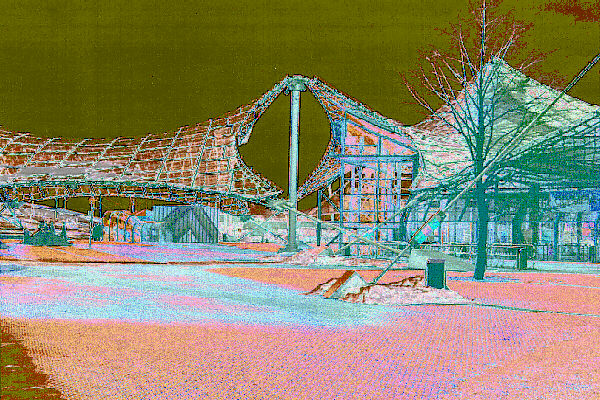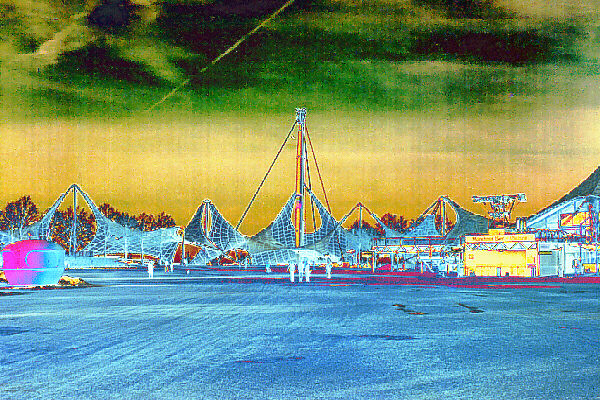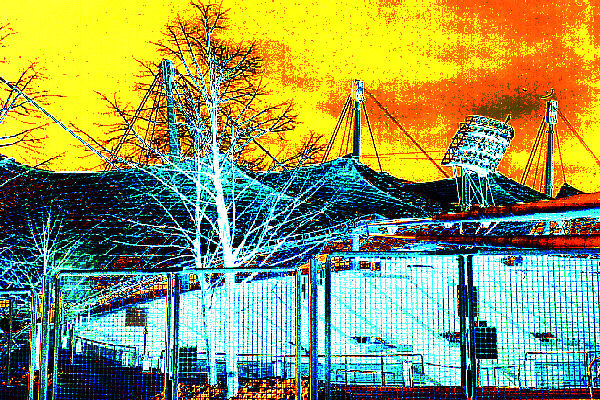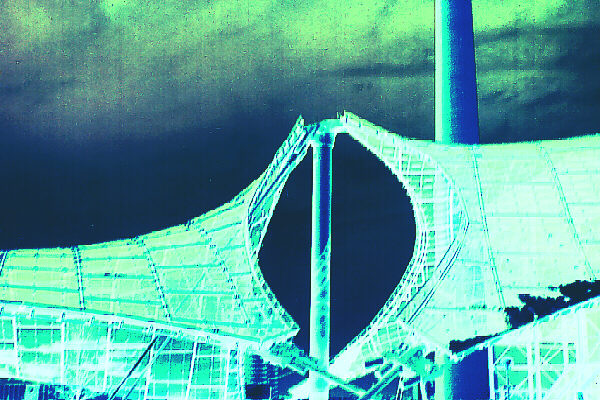2001.01.14
More Tedious Stuff (Design Process Type)
Paul states:
This is where the "function" enters the genesis of the parti. Kahn spoke of "served" and "servant" spaces, of course. The secondary spaces are not "celebrated," but become embedded in "conceptual poché," which the parti diagrams as solid, leaving only the celebrated, or publicly experienced, spaces as "spatial figure." The figure-ground gestalt is fundamental to this basic design strategy, applied to urban design by Colin Rowe and his school, but derived from Beaux Arts practice.
Steve replies:
I don't see Paul's capsulation of Kahn's notion of "served" and "servant" spaces as altogether correct. Rather, it is more of a (convenient) pedagogical interpolation based on a hybridization of "served and servant" (Kahn) with "figure/ground" (Rowe). Two of Kahn's buildings that most manifest the "served" and "servant" notions are the Richards Medical Research Building (Philadelphia, 1957-60) and the Salk Institute (La Jolla, 1959-65). In both designs the "served" and the "servant" are each clearly articulated, and one could go so far as to say that it is more the articulation of the "servant" spaces that manifest the "served" spaces. Neither of these two buildings employs what might be described as poché.
I now wonder whether Paul's interpolation exemplifies a wider ranging interpolation throughout architectural academia since Kahn's practice, hence a not necessarily true interpretation /proliferation of Kahn's message /meaning vis-à-vis "served" and "servant". The notions of "served" and servant" are first to be applied to the program, i.e., the building program is divided into those spaces that serve and those spaces that are served. The form of the building then arises out of the articulation of both the "served" and the "servant", and the ultimate design is the integration and/or inter-relation of the two types of "spaces".
Perhaps the only slanted aspect of Kahn's notion of "served" and "servant" spaces is the underlying notion that some spaces are privileged while the other spaces are not privileged. And perhaps this is precisely where the misinterpretation of "served" and "servant" actually comes from. In reality, however, Kahn somehow managed to "privilege" virtually all the spaces of his buildings. [And perhaps it can be said that Kahn was therefore very good at working the mediocre.]
Just now I'm wondering whether the grammatical terms of "active" and "passive" might be an interesting extension of the served and servant notions, i.e., with served being the passive and the servant being the active. It might be interesting to sometimes analyze buildings by identifying those parts/spaces that are active (doing the acting) and those parts that are passive (being acted upon). This point of view might help alleviate the "privilege" factor.
2001.01.15
Quondam as hypermuseum
01. continuation of "Lauf Haus der Kunst".
02. lots of new museum (model and plan) play.
03. museum annex development.
04. the working title museum.
05. something to do with the Ryerss Museum.
06. the local acropolis.
08. a solarized "photography" exhibit.
10. IQ as the plan of a hypermuseum(?).
...Quondam as hypermuseum to be the manifestation of designing and practicing (architecture) in cyberspace ideas... Quondam to display an exploitation of data in the digital realm to create entities that (can) only exist in the digital realm.
2001.01.16
virtual architecture
I agree wholeheartedly that cyberspace offers a "parallel" realm within which to design and 'build'. The term I've used instead of parallel is 'other', as in the best architecture in cyberspace is something other than the architecture of the real world. I too am not interested in seeing the architecture of cyberspace merely being a reenactment of the real world. The real world of architecture already does an excellent job of reenacting itself.
What you say about amazon.com being mostly akin to catalogue shopping is true, but there is still more to amazon in that the catalogue is hypersized, and that many of the additional services such as automatic recommendations of similar products and free out-of-print book searches make for good usability. You didn't say anything about eBay, however, which is much more 'other' than the heretofore traditional auction house.
Oddly, I've never read Neuromancer, but that might be because when the book was published (1984) I was already well immersed in Intergraph 2D and 3D cad--drawing and designing in cyberspace was already a fact for me then, and definitely not a fiction. (Should I read the book now?)
2001.02.20
Museum Collecting -- ideas, collection
Altes Museum
Museum for Nordrhine-Westfalen
Wallraf Richartz Museum
Arts and Crafts Museum
House 10 (Hejduk)
Museum of Knowledge
Kimbell (barely)
Seroux's Histoire
Durand's Recueil
Denkmal plates
1880s engravings
Working Title Museum
Museum Annex
Acropolis Q
seeking precedents... ...finding inspiration
| |
2001.03.15
QA001: Munich '72




| |
2001.04.24
Quaestio Abstrusa Background
008 013 014 016 017 022 027
2001.04.25
Quaestio Abstrusa Background
028 031 032 033 034 035 037 038 039 040 043 045 046 050 054 055 087 088 089 092 093 094 099
2001.04.26
Quaestio Abstrusa Background
105 106 107 108 109 110 111 112 113 114 115 116 117 118 119 120 121 122 123 124 125 126 127131 132
2001.04.27
Quaestio Abstrusa Background
135 136 137 138 140 141 142 143 144 145 146 147 148 152 153 154 161 162 163 164 165 166 167 168 169 170 171 172 173 174 175 176 177
2001.04.28
Quaestio Abstrusa Background
178-185 188-191 196-204 211 215-249
2001.04.29
Quaestio Abstrusa Background
251 256-258 260-264 266-269 271-283
2001.04.30
Quaestio Abstrusa Background
284-308 313 339 341-346 353-359 361-368 377-380 382-392 395 399 400
2001.05.02
Quaestio Abstrusa Background
401-414 416-419 421 422 425 427-438 443 439 444-454 458- 464 467 472 474-479 481-485 488 490 493 495 500
2001.07.17
virtual museum commentary
Virtual museums, that is, those museums that exist within the cyberspace of the Internet, travel to individuals rather than having individuals travel to them. The virtual museum in its fundamental 'approach' is exactly opposite that of a real museum.
Virtually anyone can now create a virtual museum, and perhaps the more a virtual museum is unlike a real/traditional museum the better.
Perhaps someday someone will write a book entitled Virtual Standards.
Quondam's collection, moreover, is unlike any traditional museum collection because it continually generates its own growth. Digital data has the inherent ability to spawn more and more new digital data.
In Quondam thinking, content is preferred over display.
2001.07.21 11:32
Piranesi, Duchamp and Mustard
Use your imagination when it comes to the subject. The object is to be a self-publishing museum.
010807 House for Otto 1
3709j
010810 Haus der Kunst
3709k
2001.08.13
Museum Collecting archive
A collection of the digital images of the various museums that will be featured in Museum Collecting.
A sampling of some unusual aspects...
2001.08.18 15:32
Happy Saint Helena Day
Then I took R. to Ryerss Mansion and Museum in Burholme Park. I've 'rediscovered' this place last December. It's one of those places you pass all the time, but never bother to look inside of. It's my new favorite place. I describe it as "'Venturi Shops' 100 years ago" because the VSBA 1995 exhibit Venturi Shops unwittingly reenacts exactly what Ryerss Mansion and Museum is, namely, an exhibition of things bought during excursions of India and the Far East (albeit 100 years ago). Because Ryerss is actually a museum of someone's shopping, there is an interesting Koolhaasian reenactment manifested here as well. Additionally, I tell R. my new typological interest is houses that morph into museums, of which Ryerss Mansion is a prime example of as well.
2001.09.21 18:02
metabolic/delivery, etc.
In the recent Barbara Flanagan article in Metropolis on Venturi and Scott Brown it states:
And when Venturi envisions an electronic "facade of glittering information," the inevitable political question (what does it say and who decides?) can be a vexing one. "What the message is I don't know, and I'm not too ashamed of not knowing," Venturi says. "Content is not the architect's job."
I think Venturi here admits his most present flaw, and even goes on to make a big mistake about the future. As the architect of the first online virtual museum of architecture, I see content as very much the job of the architect.
Can it be said that precisely attacking flaws engenders paradigm shifts?
Kind-of like going into a black hole and then being in the other side.
| |
2001.09.23 10:15
Re: content
2. It will be simple enough to ask Venturi himself what he means by "content is not the architect's job," at the symposium in NYC this coming Saturday.
3. As it stands, I think Venturi's quote misleads in that content CAN now well be the architect's job. Whether or not content SHOULD be the architect's job is not the issue I'm proposing.
4. There may be one answer to "what is the content?" in some of Venturi's own prior writings/statements. For example, in the early 1980s Venturi very much championed buildings with all-over patterning. With programmable electronic screens as facades, there is now every opportunity for architects to design facades with many animated patterns.
5. After spending all of the last five years generating the content for and programming several thousand 'screens' of Quondam, I might just have more experience than any other architect when it comes to architecture as the delivery of content.
"Architecture as delivery of content" describes precisely what I see as a forthcoming issue for architects.
2001.10.18 13:13
Re: building text
You know, if I were a blind person, encountering a building covered with braille might be something that takes my appreciation of both history and architecture to a new level, because then I might have a pretty good idea of how ancient Egyptians felt when they 'sensed' their buildings.
2001.10.19 20:51
Re: building text
It's interesting to 'see' what new imaginings manifest once one begins to think of architecture as the delivery of content.
2001.11.20 13:16
20 November 1996
Five years ago today was the last day that there was no such thing as Quondam - A Virtual Museum of Architecture. Since that time the notion of architect's designing virtual museums has become somewhat vogue, but www.quondam.com has never received 'official' recognition as the first (or at least oldest) virtual museum to be designed by an architect. Oddly, the Guggenheim Virtual Museum has received enormous press and official recognition, yet, in complete irony, it does not even exist as an online entity despite its self proclamation as being the most important virtual building of the 21st century. Quondam used to offer an online journal entitled Not There. Perhaps it's now time for Quondam to start handing out the Not There award.
www.quondam.com today manifests architecture as the delivery of content. Moreover, Quondam strives to deliver architectural content that is not available anywhere else, thus generally following the dictum that a virtual museum should be what a real museum cannot be.
2001.11.27 12:44
Re: Microsoft's eHomes
I've been sending most of the last week or so organizing the domestic (cad) databases in Quondam's collection in preparation for a forthcoming exhibit/publication simply entitled Domestic Databases. Right now I'm just checking out and becoming more familiar with what Quondam has, but I'm also trying to evaluate what kind of potential such a collection of data holds. For example, might architects find it interesting and useful to design homes/housing with such databases at hand? Or, might the product of architects be a house design plus an accompanying 'domestic database'?
What if more and more homes have walls of large screens -- instead of paint or wallcovering, just select what you want the wall to look like from the database -- family portrait gallery today, museum gallery tomorrow, live feed from the space shuttle the day after. Design here is no longer about controlling the way things look or are arranged, rather about providing choice and potential.
These are just very preliminary ideas, and not exactly original, but the point is that architects could well be more and more the designers of domestic content.
|



